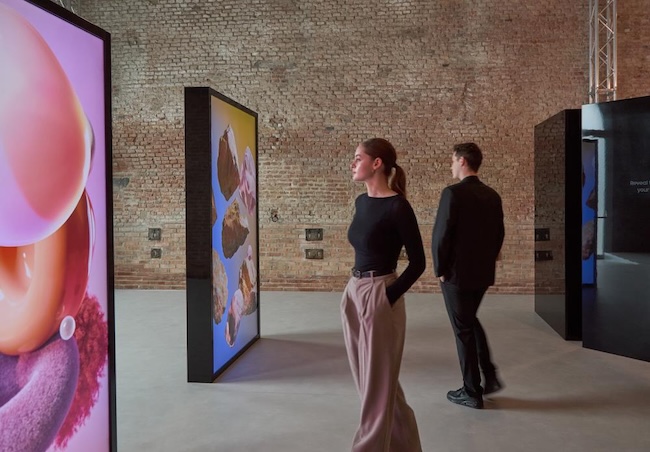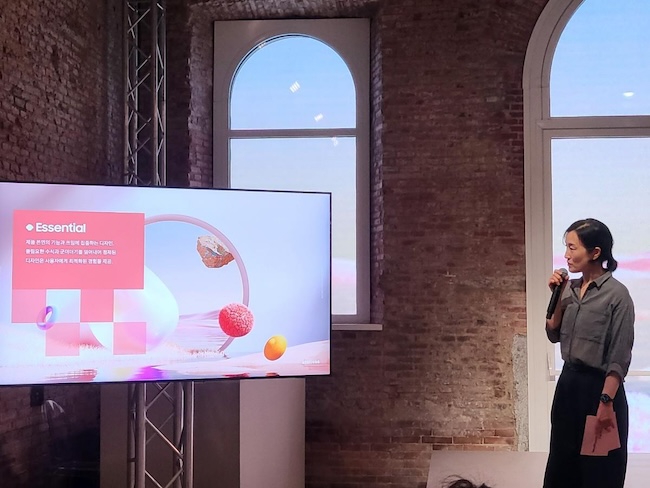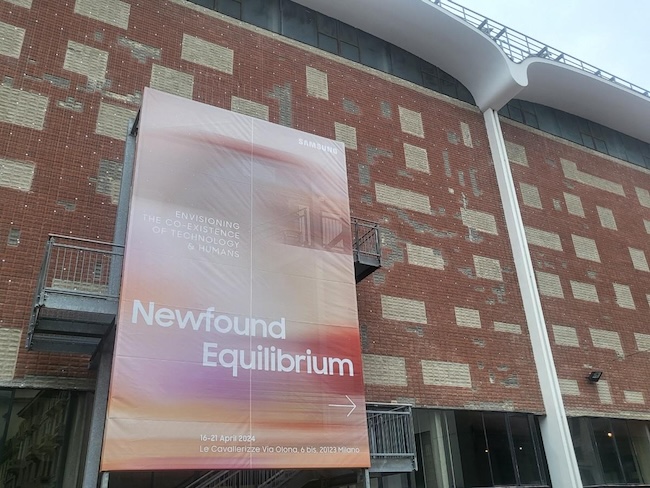
The ‘Newfound Equilibrium’ exhibition hosted by Samsung Electronics (Image courtesy of Samsung Electronics)
MILAN, Apr. 16 (Korea Bizwire) – The crucial moment when a product captivates a consumer’s heart lasts an average of 0.6 seconds, and if a company fails to seize that fleeting opportunity, it cannot emerge victorious.
This realization prompted Lee Kun-hee, the former chairman of Samsung, to gather his top executives in Milan, the global capital of fashion and design, in April 2005 for a strategy meeting focused on design management.
Lee, who had long emphasized that “design will be the last battleground for corporate management in the 21st century,” bluntly declared at the meeting that “Samsung’s design is still second-rate” and called for a design revolution.
The 2005 “Milan Design Declaration,” following the proclamation of 1996 as the “Year of Design Revolution,” encapsulated the late chairman’s commitment to “design management” while representing a pivotal moment that propelled Samsung into the top tier of global companies.
The Bordeaux TV, released the year after the Milan declaration, embodied this design-driven ethos. Fashioned after a wine glass, Samsung sold over 1 million units of the TV within six months of its launch, enabling the company to surpass Sony and claim the top spot in global TV market share—a position it has maintained for 18 consecutive years.
Since defining its design philosophy in 1996 as “starting from the user to encompass tomorrow,” Samsung Electronics has continuously empowered its design management by establishing a “Design Identity” (DI) that evolves with the times. The company also pioneered the concept of “lead design.”
As the era of artificial intelligence (AI) dawns, Samsung Electronics has outlined “Essential, Innovative, and Harmonious” as its design aspirations for 2030.

Hong Yoojin, vice president of Samsung Electronics’ Design Management Center (Image courtesy of Yonhap)
“The defining characteristic of our time is the transformative power of AI, which is changing everything,” Hong Yoojin, vice president of Samsung Electronics’ Design Management Center, told reporters in Milan on April 15, ahead of the company’s “Future of Coexistence” exhibition. “Essential, Innovative, and Harmonious are the outcomes of our discussions on pursuing customer-centric design.”
Spearheading these design strategies and directions are Samsung’s global design research institutes. The company currently operates seven such institutes worldwide, including locations in Seoul (South Korea), San Francisco (U.S.), London (U.K.), Milan (Italy), Beijing (China), Noida (India), Tokyo (Japan) and São Paulo (Brazil).
With a workforce of over 1,500 designers, these institutes bring together experts from diverse backgrounds, including product designers, user interface (UI) and user experience (UX) specialists, as well as professionals in fields like psychology, cognitive science, and mechanical engineering, all collaborating to drive innovation.
The European Design Institute, established in London in 2000, carries the dual responsibility of upholding European design traditions while translating emerging trends into globally applicable designs.

The ‘Newfound Equilibrium’ exhibition hosted by Samsung Electronics (Image courtesy of Samsung Electronics)
Meanwhile, the Milan branch, founded in 2005, specializes in color and materials research. It investigates materials and related technologies utilized in disparate industries, such as furniture, interior design, automotive, and fashion, to explore their potential applications in electronics. The institute excels in collaborating with high-end premium material companies for development projects.
In 2020, the Milan institute partnered with the renowned Italian metalworking artisans of De Castelli to create the “Mare Blue” door panels for the New Chef Collection refrigerators. Each panel, meticulously created by craftsmen over five weeks, boasts a unique pattern, lending an air of exclusivity.
The realm of “Color, Material, and Finishing” (CMF) plays a pivotal role in enhancing a product’s emotional and functional value by formulating design strategies and optimizing colors, materials, and details.
Grounded in market research encompassing trends, lifestyles, and emerging materials, the CMF strategy aligns with a product’s characteristics, creating points of differentiation that set it apart.
“Through groundbreaking technology that offers boundless possibilities and design that challenges conventional thinking, we seek to uncover innovative touchpoints,” said Felix Heck, head of Samsung Electronics’ European Design Institute. “Our aim is to open new frontiers of possibility through Samsung’s diverse product lineup.”
Kevin Lee (kevinlee@koreabizwire.com)






